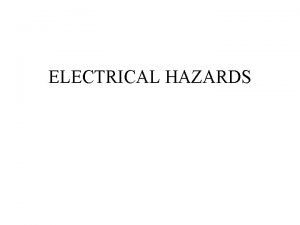Electrical Safety Electrical Shock comes from too much








- Slides: 8

Electrical Safety Electrical Shock comes from too much I with too little R human R ≈ 500, 000 Ω if dry skin but R ≈ 100 Ω if wet with salt water That’s 5000 x’s less R, so 5000 x’s more I for same V! Effects of Electrical Current on the Body 1 m. A can be felt 5 m. A painful 10 m. A involuntary muscle contraction 15 m. A loss of muscle control 70 m. A (. 07 A) probably fatal if thru heart for > 1 sec Note it only takes 70 x’s more current to go from just sensing it, to it being strong enough to kill.

Electrical Safety Worst situation: Current through your heart! Electrician’s Safety Motto: “always work with one hand in your pocket” Is 120 V outlet dangerous? Yes, in certain situations like when water’s involved and it’s through your heart. What about a bird/squirrel on a wire? No problem, since all same (high) potential. It’s actually current that kills, not voltage. DANGER: High Voltage signs really should read DANGER: Lots of Current

Electrical Safety Plugs – a way to place an electrical device “in the way of” charges moving from high to low potential ► Oldest: 2 = size prongs ► Then: 3 prongs, 2 = & 1 semi round. Called “grounding” It grounded entire device from some faulty wiring or a short that developed inside by connecting the case of the device directly to the ground – (green wire) Needed 3/2 adaptors or just cut it off… ► Now: Polarized, 2 ≠ size prongs larger hole - neutral (white/gray wire) smaller hole - hot (black wire) Assures plug always grounds device by connecting neutral wire to neutral hole. Cheaper than 3 prongs and usually good enough.


Circuit Breakers (new) & Fuses (old) Background: ► Lots of different circuits in your home, each rated for “appropriate” amount of I. (But older homes, not so much, as we didn’t use to have so much to plug in. ) ► Different wires rated for different amounts of I, but the more I it can handle, the more expensive it is. ► Too much I - called overloaded - gets the wires too hot, starts fires!

Circuit Breakers (new) & Fuses (old) Purpose: to be the weakest part of any circuit, so if there’s ever too much current being pulled, or a dangerous short somewhere, then that’s where the circuit would shut down, by ► Breakers: flip the switch to open “trip the breaker” ► Fuses: burn a break in the wire “blew a fuse” To fix the circuit, 1 st reduce the amount of I being pulled, by unplugging something. Then ► Breakers: simply flip switch back. ► Fuses: need to replace with a new one. But this was a problem: if you didn’t have another one handy, then often used foil or a penny, but that’s no longer the weakest spot…

Extension Cords – simply lengthens the distance available from device to outlet § More length increases R, so be careful (don’t use with room heaters) § Heavier gauge wire safer so more I available, but more expensive. ► Strip Plugs / Multi-plug Adaptors – simply provide more space for more devices to be plugged in § More devices, pull more I, so be careful § Come rated for various amt of I, then priced accordingly. ► Surge Protectors – designed to protect electrical devices from voltage spikes by either blocking or by shorting to ground voltages above a safe levels. ►

GFCI or GFI: Ground Fault Circuit Interrupter Can be located on a plug, outlet, circuit breaker ► Shuts down a circuit in which more I is being pulled in, than is coming back out! ► This won’t be enough I to trip the breaker, but is likely enough to harm/kill someone. Consider a hairdryer that usually pulls 7 A, gets dropped into a bathtub of water while running. It continues running at 7 A, so it won’t trip the 15 A breaker, but the flow of current is now exiting via the water and plumbing of the tub, which is always grounded, instead of the set route of out the other prong on the plug. If there’s a person in the water, this is more than enough current to kill them. ►














